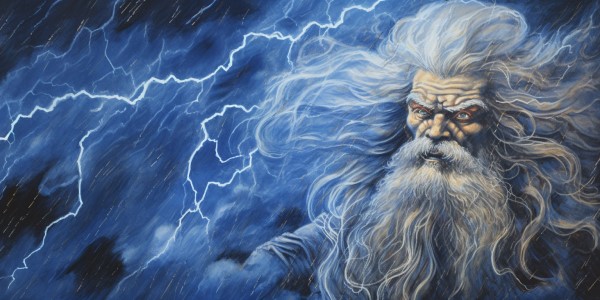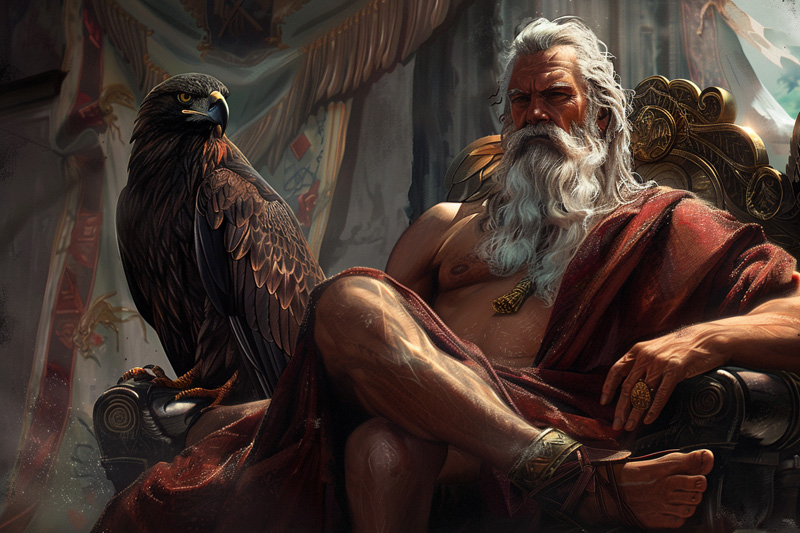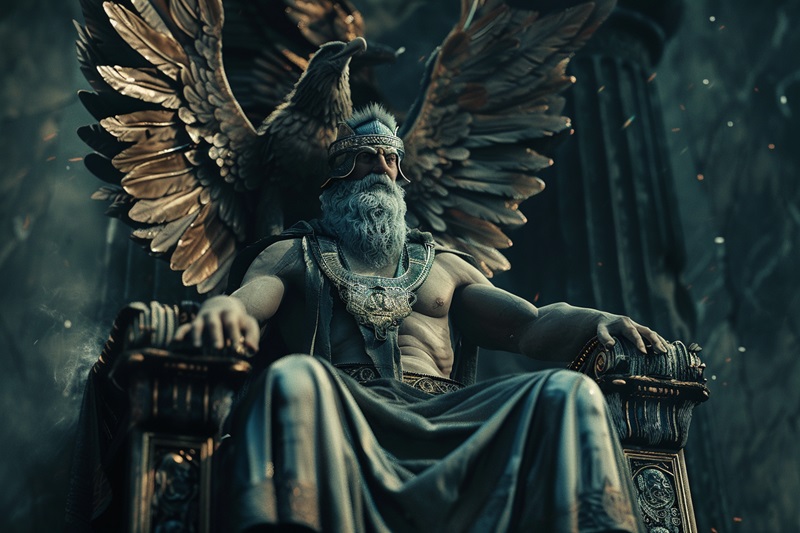KidZone Geography: Greek Mythology
About Zeus, ruler of the Greek gods
Introduction to Zeus
Zeus, the king of the gods in ancient Greek mythology, is a central figure in Greek religion and myth. Known as the god of the sky, lightning, and thunder, he rules over Mount Olympus and presides over the pantheon of Greek deities. Zeus is often depicted with a thunderbolt in his hand, symbolizing his power to control the elements. He is also associated with justice and law, serving as a protector of order and the enforcer of divine will.

Quick Facts About Zeus
What is Zeus the Greek god of?
Zeus is the Greek god of the sky, lightning, thunder, and justice. As the king of the gods, he holds supreme authority over Mount Olympus and presides over the pantheon of Greek deities.
What are Zeus's sacred animals?
Zeus's sacred animals include the eagle and the bull. The eagle symbolizes his power and his role as the ruler of the skies, while the bull represents strength and virility.
What are Zeus's symbols?
Zeus's primary symbols are the thunderbolt, the eagle, and the oak tree. The thunderbolt represents his control over lightning and thunder, the eagle signifies his dominion over the sky, and the oak tree symbolizes strength and endurance.
Lesson Plan: Thunder and Lightning in Mythology
Origins and Birth
The Titanomachy
Zeus's origin story begins with the Titanomachy, a significant conflict between the Titans and the Olympian gods. Zeus was the youngest son of the Titans Cronus and Rhea. Fearing a prophecy that one of his children would overthrow him, Cronus swallowed each of his offspring at birth. However, Rhea managed to save Zeus by hiding him on the island of Crete and giving Cronus a stone wrapped in swaddling clothes instead.
The Rise of Zeus
Zeus grew up in secret and eventually matured into a powerful deity. With the help of his siblings—Poseidon, Hades, Hera, Demeter, and Hestia—whom he rescued from Cronus's stomach, Zeus waged war against the Titans. This epic battle, known as the Titanomachy, lasted for ten years and ended with the defeat of the Titans. Zeus and his siblings claimed dominion over the cosmos, with Zeus becoming the supreme ruler.
Zeus's Role in Greek Mythology
Supreme Ruler and Protector
As the king of the gods, Zeus's primary role was to maintain order and justice among both gods and mortals. He was often called upon to mediate disputes and enforce oaths, ensuring that the natural order was upheld. Zeus's authority extended over the heavens, earth, and underworld, making him a central figure in the functioning of the universe.
God of the Sky and Thunder
Zeus's association with the sky and weather is one of his most defining characteristics. He was believed to control lightning, thunder, and rain, wielding these elements to assert his power. Temples and altars dedicated to Zeus were often located on mountaintops or high places, reflecting his dominion over the sky.
Iconography and Symbols
The Thunderbolt

The thunderbolt is Zeus's most recognizable symbol, representing his ability to control the forces of nature. According to myth, the Cyclopes forged the thunderbolts as weapons for Zeus during the Titanomachy. These powerful weapons were used to defeat the Titans and secure Zeus's place as the ruler of the gods.
The Eagle

The eagle is another prominent symbol associated with Zeus. Known for its strength and keen vision, the eagle was considered a sacred animal to the god. It often appeared in art and mythology as Zeus's messenger or as a representation of his watchful presence over the world.
The Oak Tree
The oak tree was sacred to Zeus, symbolizing strength and endurance. The oracle at Dodona, one of the oldest Greek oracles, was situated in a grove of oak trees. Priests and priestesses interpreted the rustling of the leaves and the flight of birds as messages from Zeus.
Major Myths Involving Zeus
The Birth of Athena
One of the most famous myths involving Zeus is the birth of Athena, the goddess of wisdom and warfare. According to the myth, Zeus swallowed his first wife, Metis, while she was pregnant, fearing that their child would be more powerful than him. Later, Zeus experienced a severe headache, and with the help of Hephaestus, who split his head open with an axe, Athena emerged fully grown and armored.
The Abduction of Europa
Another well-known myth is the abduction of Europa. Zeus fell in love with Europa, a Phoenician princess, and transformed himself into a beautiful white bull to approach her. Europa was captivated by the gentle bull and climbed onto its back. Zeus then swam across the sea to the island of Crete, where he revealed his true identity and made Europa the queen of Crete.
The Punishment of Prometheus
Zeus also played a key role in the myth of Prometheus, the Titan who defied the gods by giving fire to humanity. As punishment, Zeus ordered Prometheus to be chained to a rock on Mount Caucasus, where an eagle would eat his liver daily, only for it to regenerate each night. Prometheus's torment continued until he was eventually freed by Hercules.
Zeus and the Defeat of the Titans
Zeus's Relationships and Offspring
Marriages and Consorts
Zeus was known for his numerous relationships with both goddesses and mortal women, resulting in a large number of offspring. His primary wife was Hera, the queen of the gods, who was often jealous of Zeus's infidelities. Despite their tumultuous relationship, they had several children together, including Ares, Hebe, and Hephaestus.
Zeus also had affairs with other goddesses such as Demeter and Leto, as well as mortal women like Alcmene and Leda. These unions produced many famous figures in Greek mythology, including:
- Heracles (Hercules): Son of Zeus and Alcmene, known for his incredible strength and his twelve labors.
- Helen of Troy: Daughter of Zeus and Leda, whose abduction sparked the Trojan War.
- Apollo and Artemis: Twin children of Zeus and Leto, representing the sun and moon, respectively.
- Perseus: Son of Zeus and Danaë, celebrated for slaying Medusa and rescuing Andromeda.
Divine Offspring
Zeus's divine children also played significant roles in Greek mythology. Some of his notable divine offspring include:
- Athena: Born from Zeus's head, the goddess of wisdom and war.
- Hermes: Son of Zeus and Maia, the messenger god known for his speed and cunning.
- Dionysus: Son of Zeus and Semele, the god of wine, pleasure, and festivity.
Worship and Cult of Zeus

Temples and Sanctuaries
Zeus was worshipped throughout the ancient Greek world, with numerous temples and sanctuaries dedicated to him. The most famous of these was the Temple of Zeus at Olympia, which housed a colossal statue of the god made by the sculptor Phidias. This statue was considered one of the Seven Wonders of the Ancient World.
Another important site of worship was Dodona, where an ancient oracle dedicated to Zeus provided guidance through the interpretation of the rustling leaves of the sacred oak trees. The oracle was believed to be one of the oldest in Greece and was highly revered.
Festivals and Rituals
Several festivals were held in honor of Zeus, the most notable being the Olympic Games. These games were held every four years at Olympia and included athletic competitions, religious ceremonies, and sacrifices to Zeus. The Olympics served as a unifying event for the Greek city-states and celebrated physical prowess and divine favor.
Other festivals included the Diasia, a rural festival held in Athens, and the Nemean Games, similar to the Olympics but held at Nemea in honor of Zeus Nemeios.
Zeus in Art and Literature
Classical Depictions
Zeus has been a popular subject in art and literature for centuries. In classical art, he is often depicted as a regal, bearded man holding a thunderbolt or seated on a throne. These representations emphasize his authority and power as the king of the gods.
Renaissance and Beyond
During the Renaissance, artists like Michelangelo and Raphael drew inspiration from classical depictions of Zeus, incorporating him into their works. Michelangelo's depiction of Zeus in the Sistine Chapel is a prime example of how the god's imagery was adapted into Christian contexts, often blending with representations of God the Father.
Modern Interpretations
In modern times, Zeus continues to be a prominent figure in literature, film, and popular culture. He appears in various forms, from comic books and movies to television series and video games. These contemporary portrayals often explore different aspects of his character, from his might and wisdom to his flaws and complexities.
Conclusion
Zeus remains one of the most enduring and influential figures in Greek mythology. His stories and symbols have transcended time, continuing to captivate and inspire people around the world. As the god of the sky and thunder, the king of the gods, and a central figure in countless myths, Zeus's legacy is deeply embedded in the fabric of Western culture and history. Through his worship, iconography, and the rich tapestry of stories that surround him, Zeus exemplifies the complexities and grandeur of ancient Greek religion and mythology.





